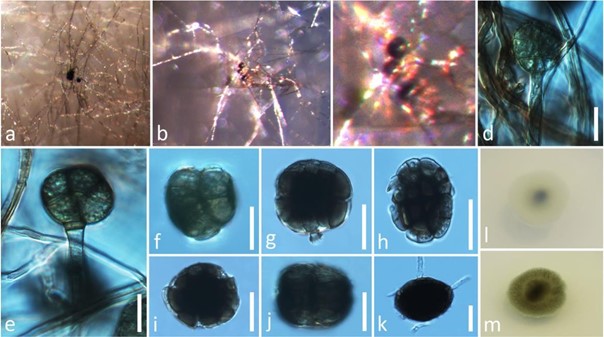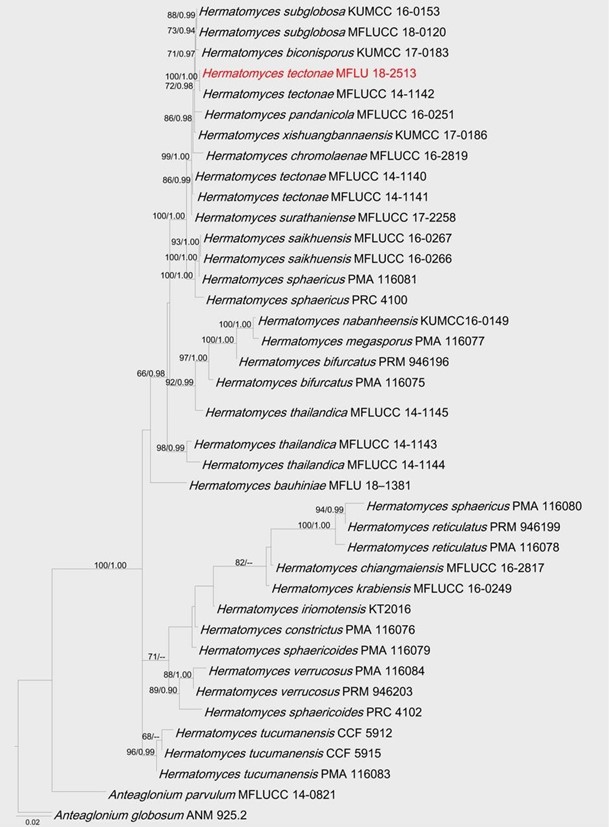Hermatomyces tectonae Doilom D.J. Bhat & K.D. Hyde, Fungal Divers. 82: 119 (2016). Fig. 86
MycoBank number: MB 551965; Index Fungorum number: IF 551965; Facesoffungi number: FoF 01850.
Saprobic on dead leaves of Ficus septica Burm.f. Sexual morph: Undetermined. Asexual morph: Hyphomycetous. Colonies on natural blackish brown, velvety, shiny, in small groups, glistening, conidia readily liberated when disturbed. Mycelium superficial, composed of a network of branched, septate, hyaline to pale brown, thick-walled hyphae 1.3– 2.6 μm wide. Conidiophores up to 70 μm long, 1.5–3.5 μm wide, micronematous, flexuous, pale brown, smooth, unbranched, arising from prostrate hyphae at the centre of circular colony. Conidiogenous cells monoblastic, integrated, terminal, cylindrical, hyaline to sub-hyaline. Lenticular conidia (48–)50–56(−58) μm high × (41–)42–48(−49.5) μm diam., monomorphic, disk-shaped, with central cells dark brown to black, with peripheral cells pale brown, thick-walled, smooth-walled. Two halves of the disk-shaped conidia symmetrically adpressed, forming a deep constriction at lower and upper end in lateral view, each half with 5–7 cells, hyaline to light brown at lower and upper cells, dark brown in middle cells.
Culture characteristics – Conidia germinating on PDA within 10 h and germ tubes produced from the apex. Colonies growing on PDA, reaching 3 cm in 8 days at 30 °C, mycelium partly superficial, partly immersed, slightly effuse, cottony, with regular edge, grey above, pastel grey from below; sexual or asexual spores not formed within 60 days.
Material examined – Taiwan, Chiayi, Shihnong Forest Area, decaying leaves of Ficus septica (Moraceae), 25 June 2018, D.S. Tennakoon, XP010 (MFLU 18-2513), living culture, NCYUCC 19-0171.
GenBank numbers – ITS: MT649881, LSU: MT649877, rpb-2: MT663767, SSU: MT649879, tef1: MT663765.
Notes – We report our collection as a new record of H. tectonae from dead branch of Ficus septica in Taiwan, based on morphological characters of lenticular muriform conidia, with subhyaline to pale brown peripheral cells, and dark brown central cells. However, other collections of this species are from Tectona grandis (Doilom et al. 2017). Phylogenetic analysis of maximum likelihood and Bayesian inference based on a combined ITS, LSU, rpb-2, SSU and tef1 sequence data supported our taxon, which clustered with H. tectonae (MFLUCC 14-1142) (100 % MLBS, 1.00 BYPP, Fig. 87).

Figure 86 – Hermatomyces tectonae (MFLU 18-2513, new host record). a–c Mycelia and conidia on substrate. d, e Conidia with conidiophores. f–j Lenticular conidia. k Germinated conidia. l Colony from below. m Colony from above. Scale bars: d–k = 30 μm.

Figure 87 – Phylogram generated from maximum likelihood analysis (RAxML) of Hermatomycetaceae based on ITS, LSU, rpb-2, SSU, and tef1 sequence data. Maximum likelihood bootstrap values equal or above 65 %, Bayesian posterior probabilities equal or above 0.90 (MLBS/PP) are given at the nodes. An original isolate number is noted after the species name. The tree is rooted to Anteaglonium globosum (ANM 925.2) and A. parvulum (MFLUCC 14-0821). Newly sequence is in red. The ex-type strains are indicated in bold. Hyphen (-) represents support values below 70 % MLBS and 0.90 PP
